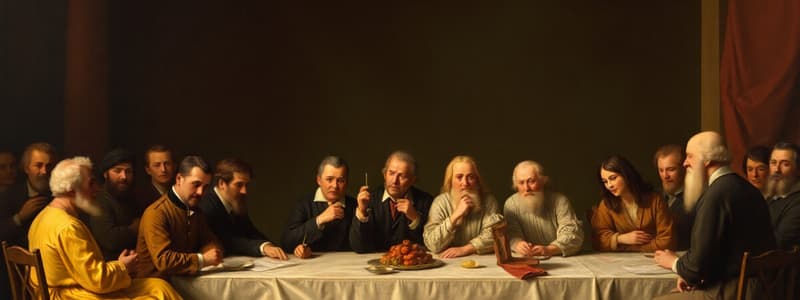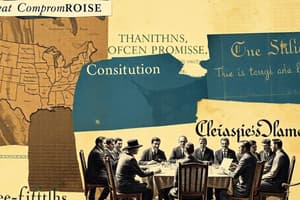Podcast
Questions and Answers
What was the main issue that delegates had to address in the discussions?
What was the main issue that delegates had to address in the discussions?
- The economic policies of each state.
- The number of states that would join the union.
- The capital city of the United States.
- The amount of power each state would retain. (correct)
Which two plans were presented by delegates regarding representation?
Which two plans were presented by delegates regarding representation?
- The Massachusetts Plan and the Connecticut Plan
- The Pennsylvania Plan and the Georgia Plan
- The Virginia Plan and the New Jersey Plan (correct)
- The Maryland Plan and the New York Plan
What was the outcome of the Great Compromise?
What was the outcome of the Great Compromise?
- A bicameral legislature with both equal and population-based representation. (correct)
- Complete dissolution of state powers.
- A unicameral government system.
- Equal representation for all states in both houses.
How many delegates signed the Constitution on September 17, 1787?
How many delegates signed the Constitution on September 17, 1787?
What did ratification of the Constitution require?
What did ratification of the Constitution require?
Which state was the first to ratify the Constitution?
Which state was the first to ratify the Constitution?
What were some delegates concerned about regarding the Constitution?
What were some delegates concerned about regarding the Constitution?
Which influential figures supported the Constitution?
Which influential figures supported the Constitution?
What type of legislation did the Virginia Plan propose?
What type of legislation did the Virginia Plan propose?
Which plan called for equal representation from each state in the upper house?
Which plan called for equal representation from each state in the upper house?
The Great Compromise resulted in a Congress with two houses: the Senate and the House of Representatives.
The Great Compromise resulted in a Congress with two houses: the Senate and the House of Representatives.
The Virginia Plan proposed a unicameral legislature.
The Virginia Plan proposed a unicameral legislature.
Delaware was the last state to ratify the Constitution.
Delaware was the last state to ratify the Constitution.
Under the Great Compromise, all states would have equal representation in the House of Representatives.
Under the Great Compromise, all states would have equal representation in the House of Representatives.
The New Jersey Plan advocated for equal representation regardless of state size.
The New Jersey Plan advocated for equal representation regardless of state size.
The Constitution became law when all thirteen states ratified it.
The Constitution became law when all thirteen states ratified it.
Benjamin Franklin and George Washington opposed the Constitution.
Benjamin Franklin and George Washington opposed the Constitution.
States with larger populations had fewer representatives in the House of Representatives.
States with larger populations had fewer representatives in the House of Representatives.
The ratification process was initiated after the signing of the Constitution.
The ratification process was initiated after the signing of the Constitution.
There were 39 delegates who signed the Constitution on September 17, 1787.
There were 39 delegates who signed the Constitution on September 17, 1787.
Flashcards are hidden until you start studying
Study Notes
The Great Compromise
- The delegates of the Constitutional Convention debated the balance of power between the national government and individual states.
- They needed to determine how much power each state should hold, particularly regarding representation in the Congress, given the differing populations between states.
- Two proposals were presented: the Virginia Plan, advocating for proportional representation based on population, and the New Jersey Plan, proposing equal representation per state.
- The Connecticut Compromise, also known as the Great Compromise, was a solution that resulted in a bicameral legislature.
- The Senate, with two senators per state, would ensure equal representation regardless of population size.
- The House of Representatives, with representation based on population, would favor larger states.
Ratification of the Constitution
- On September 17, 1787, 39 delegates signed the Constitution.
- The Constitution officially became law when nine of the thirteen states ratified it.
- Delaware was the first state to ratify the Constitution, followed by Pennsylvania.
- The ratification faced opposition from individuals concerned about relinquishing state power.
- Notable figures like Benjamin Franklin and George Washington actively advocated for the Constitution, bolstering its support.
The Great Compromise
- The delegates at the Constitutional Convention debated the balance of power between the national and state governments.
- The key issue was representation: Should each state have equal power in the government, or should representation be based on population?
- Two plans emerged: the Virginia Plan favored larger states with more representation based on population, while the New Jersey Plan favored smaller states with equal representation.
- The Great Compromise resolved this conflict by creating a bicameral legislature with two houses:
- The Senate: Each state would have equal representation.
- The House of Representatives: Representation would be based on the population of each state.
Ratification of the Constitution
- The Constitution was signed by 39 delegates on September 17, 1787.
- The Constitution became law after nine of the thirteen states ratified it.
- Delaware was the first state to ratify, followed by Pennsylvania.
- Some people were hesitant to ratify, fearing a loss of state power.
- Influential figures like Benjamin Franklin and George Washington publicly supported the Constitution.
Studying That Suits You
Use AI to generate personalized quizzes and flashcards to suit your learning preferences.




